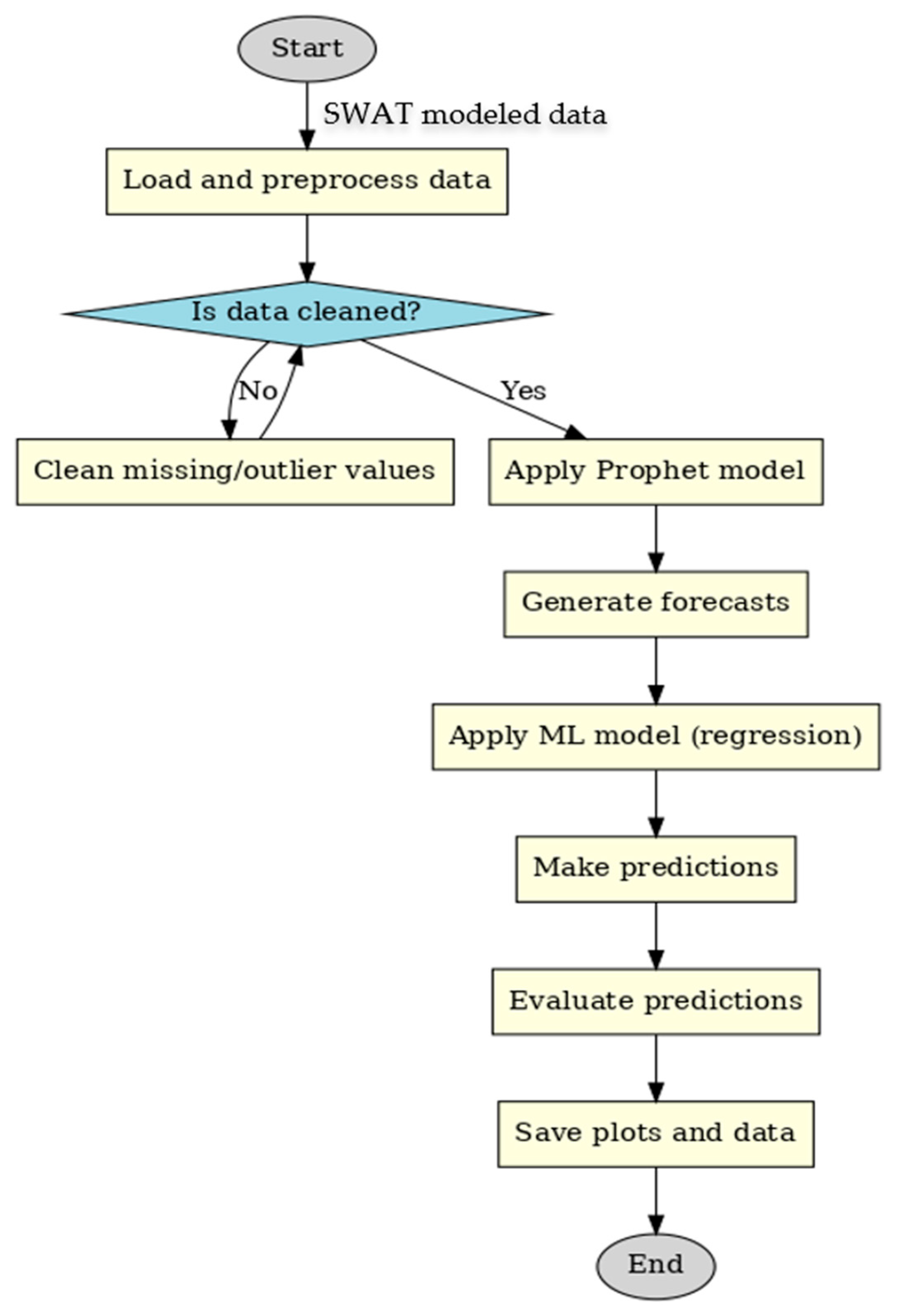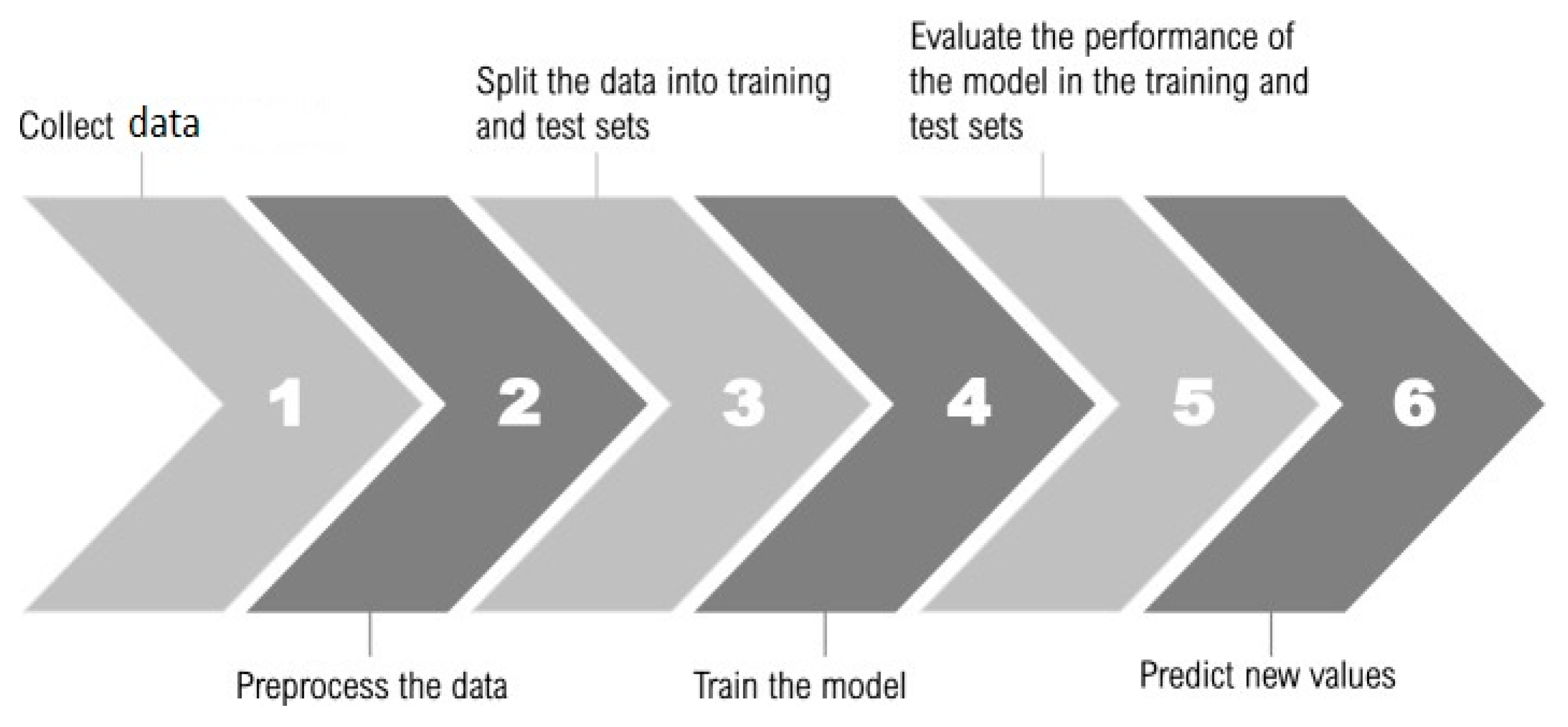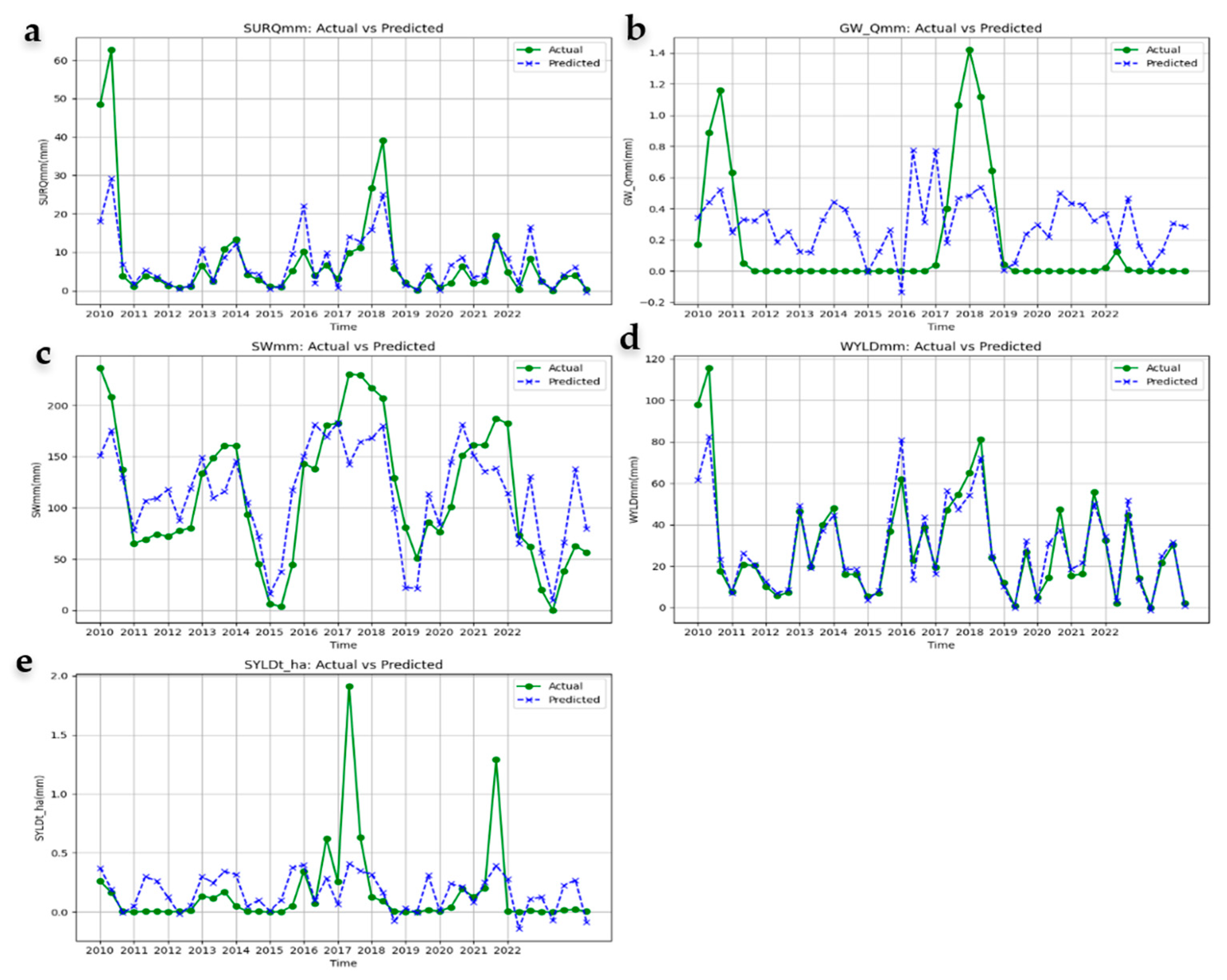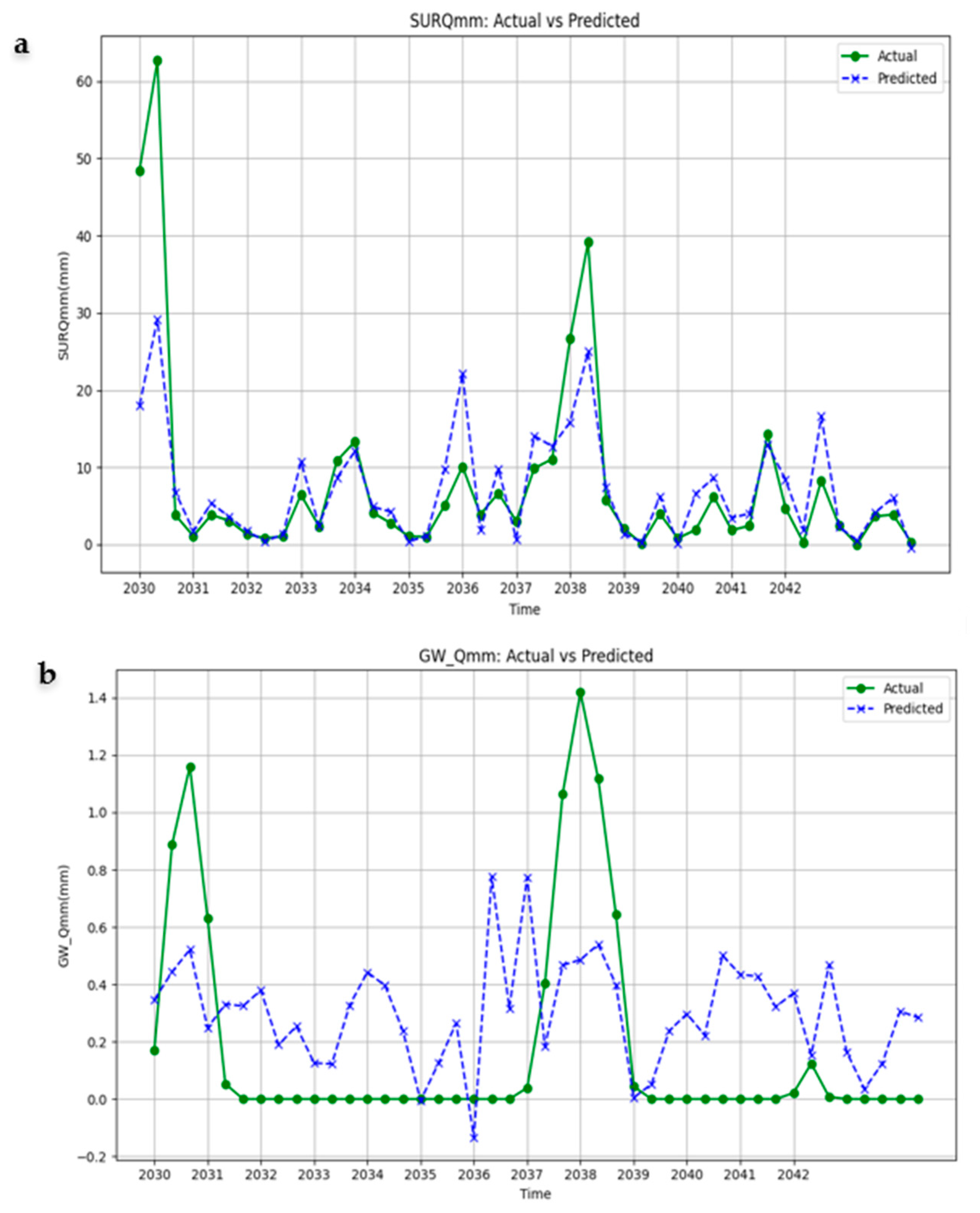Predictive Analysis of Hydrological Variables in the Cahaba Watershed: Enhancing Forecasting Accuracy for Water Resource Management Using Time-Series and Machine Learning Models
Abstract
1. Introduction
2. Data and Methods
2.1. Methodology for Hybrid Model Design
- (A)
- Apply the Prophet time-series forecasting model to predict key hydrological variables and analyze annual variations for better understanding of climate-driven hydrological patterns.
- (B)
- To integrate machine learning models (multi-output regression with polynomial features) into Prophet time-series forecasting models to better understand the complex relationships between hydrological input and output variables.
- (C)
- To validate and evaluate the performance of predictive models by comparing Prophet-machine learning model outputs with SWAT model simulations in the Cahaba watershed.
- (D)
- Perform comparative analysis of predicted vs. actual water balance components and hydrological responses under both present (2010–2022) and future (2030–2042) climate scenarios in the Cahaba watershed.
2.2. Study Area and Benchmark Modeling with SWAT Model
2.3. Hydrological Data Predictions Using Prophet Library
2.4. Time-Series Forecasting with Prophet Model
2.5. Fusing Machine Learning Model for Enhanced Prophet-SWAT Predictions
2.5.1. Machine Learning Model Selection and Interpretability
2.5.2. Model Training and Evaluation Strategy
2.6. Hydrological Scenarios
3. Results
3.1. SWAT Model Accuracy and Calibration Settings
3.2. SWAT vs. SWAT-Prophet-ML for Water Balance Predictions in Present Climate
Limitations in Capturing Peak Events
3.3. SWAT vs. SWAT-Prophet-ML for Hydrological Response Predictions in Present Climate
3.4. SWAT-Prophet-ML-Based Water Balance Predictions in Future Climate
3.5. SWAT vs. SWAT-Prophet-ML for Hydrological Response Predictions in Future Climate
3.5.1. Limitations of the SWAT-Prophet-ML Model in Future Climate
3.6. Performance Evaluation of Various Modeling Techniques in Present Climate
Evaluation Methodology and Use of SWAT as Reference
- Lack of continuous, high-resolution observational data: Field-measured observational data for all required hydrological components (e.g., groundwater contribution, soil moisture, sediment yield) were not available at finer spatial and temporal resolution for the entire watershed.
- The SWAT model was previously calibrated and validated using available observed data (streamflow, surface runoff) for the Cahaba River Basin). Its outputs are, therefore, treated as a reliable physical baseline to evaluate enhancements from additional forecasting layers.
- This modeling chain focuses on enhancing SWAT forecasts through decomposition (Prophet) and regression (ML), not replacing SWAT. Hence, performance is measured relative to the benchmark simulation rather than raw observations.
4. Discussion and Future Work
4.1. Enhancing Model Generalization Under Future Climate Regimes
- Scenario-Based Synthetic Training: Future iterations of this model will incorporate SWAT-generated outputs under multiple Representative Concentration Pathway (RCP) scenarios as training inputs, expanding the model’s exposure to a broader range of climatic conditions.
- Data Augmentation: We plan to generate perturbed versions of climate input variables (e.g., rainfall intensity shifts, temperature anomalies) using Gaussian noise or bootstrapping methods to improve robustness to rare or extreme events.
- Physically Informed Constraints: Incorporating mass balance principles directly into the loss function or model architecture (e.g., conservation-aware ML or physics-guided neural networks) will ensure hydrologic plausibility, even when data distributions deviate from historical norms.
- Transfer Learning Techniques: Pretraining models on global climate-simulated datasets and fine-tuning on watershed-specific data could improve adaptability to novel climate regimes, especially in data-scarce basins.
4.2. Comparative Evaluation with Ensemble and Deep Learning Models
4.3. Uncertainty in Prophet Forecasts and Practical Implications
- Under present climate conditions, Prophet’s uncertainty remains relatively narrow for smooth variables like ET and PET, enhancing confidence in monthly water demand and planning decisions.
- However, for highly variable phenomena such as precipitation and snowmelt, especially under future climate projections (2030–2042), the uncertainty intervals widen substantially. This reflects not only inherent input variability but also the model’s inability to anticipate regime shifts or outliers outside the historical data distribution.
- Because the downstream ML model in the SWAT-Prophet-ML pipeline depends on Prophet outputs, errors or overconfident predictions from Prophet may propagate, potentially affecting the reliability of surface runoff, water yield, or sediment yield predictions.
- Quantile regression forests or Bayesian models to generate more robust uncertainty estimates.
- Calibration of Prophet’s uncertainty intervals using historical residual validation.
- Monte Carlo dropout or ensemble-based simulations to propagate uncertainty through the full pipeline (SWAT → Prophet → ML).
- Expressing results not just as deterministic outputs but as probabilistic forecasts that better support risk-informed decision-making.
5. Conclusions
- Model demonstrated strong predictive performance for water yield (R2 = 0.75), surface runoff (R2 = 0.70), evapotranspiration and potential evapotranspiration (RMSE = 15–20 mm)
- Accurate modeling of seasonal trends and smooth climatic behavior was achieved using the Prophet-decomposed features.
- Precipitation and snowmelt showed higher variability and were less accurately predicted (RMSE = 30–50 mm and 5–10 mm, respectively).
- Model underperformed, especially for variables like groundwater flow and sediment yield, where the hybrid model failed to capture peak years or sharp shifts.
- The main cause was the model’s reliance on stationary historical patterns, which are not representative of future climate variability.
- Lack of training on non-stationary or perturbed climate data
- Absence of physical constraints in ML predictions
- Limited capacity to simulate extreme events or abrupt hydrological shifts
- Scenario-based training using synthetic climate inputs from multiple representative concentration pathways
- Data augmentation techniques to simulate rare or extreme meteorological conditions
- Physically informed modeling, integrating hydrological constraints into the ML component
- Model benchmarking using ensemble and deep learning with SHAP-based feature interpretation
Author Contributions
Funding
Data Availability Statement
Acknowledgments
Conflicts of Interest
References
- Kode, V.R.; Preetha, P.; Kodali, D. Chapter 26—Smart boron nitride nanomaterial systems for wastewater treatment studies. In Micro and Nano Technologies, Smart Nanomaterials for Environmental Applications; Ayeleru, O.O., Idris, A.O., Pandey, S., Olubambi, P.A., Eds.; Elsevier: Amsterdam, The Netherlands, 2025; pp. 649–676. ISBN 9780443217944. [Google Scholar] [CrossRef]
- Li, Z.; Zhang, Y.; Wang, Z. Hydrological modeling using remote sensing and machine learning. J. Hydrol. 2019, 572, 678–689. [Google Scholar]
- Xu, Y.; Gao, Y.; Zhang, D. Evaluation of evapotranspiration estimation methods under climate variability. J. Hydrol. 2021, 599, 126414. [Google Scholar]
- Allen, R.G.; Pereira, L.S.; Raes, D.; Smith, M. Crop Evapotranspiration: Guidelines for Computing Crop Water Requirements. FAO 1998, 300, D05109. [Google Scholar]
- Salas, J.D.; Delleur, J.W.; Yevjevich, V.; Lane, W.L. Applied Modeling of Hydrologic Time Series; Water Resources Publications: Highlands Ranch, CO, USA, 2012. [Google Scholar]
- Taylor, S.J.; Letham, B. Forecasting at scale. Am. Stat. 2018, 72, 37–45. [Google Scholar] [CrossRef]
- Singh, A.; Jain, S.K.; Tyagi, B. Rainfall forecasting using Prophet model. Hydrol. Sci. J. 2020, 65, 716–726. [Google Scholar]
- Zubair, M.; Rehman, S. Time-series forecasting of climate variables using Prophet model. Clim. Dyn. 2022, 59, 123–135. [Google Scholar]
- Solomatine, D.; Ostfeld, A. Data-driven modeling: Some past experiences and new approaches. J. Hydroinforma. 2008, 10, 3–22. [Google Scholar] [CrossRef]
- Mosavi, A.; Ozturk, P.; Chau, K.W. Flood prediction using machine learning models. Sustainability 2018, 10, 4206. [Google Scholar]
- Preetha, P.P.; Joseph, N.; Narasimhan, B. Quantifying surface water and ground water interactions using a coupled SWAT_FEM model: Implications of management practices on hydrological processes in irrigated river basins. Water Resour. Manag. 2021, 35, 2781–2797. [Google Scholar] [CrossRef]
- Gonzalez, M.O.; Preetha, P.; Kumar, M.; Clement, T.P. Comparison of data-driven groundwater recharge estimates with a process-based model for a river basin in the southeastern USA. J. Hydrol. Eng. 2023, 28, 04023019. [Google Scholar] [CrossRef]
- Preetha, P.; Al-Hamdan, A. A union of dynamic hydrological modeling and satellite remotely-sensed data for spatiotemporal assessment of sediment yields. Remote Sens. 2022, 14, 400. [Google Scholar] [CrossRef]
- Wang, Z.G.; Liu, C.M.; Wu, X.F. A review of the studies on distributed hydrological model based on DEM. J. Nat. Resour. 2003, 18, 168–173. [Google Scholar]
- Ahmad, S.; Kalra, A.; Stephen, H. Estimating soil moisture using remote sensing data: A machine learning approach. Adv. Water Resour. Res. 2010, 33, 69–80. [Google Scholar] [CrossRef]
- Preetha, P.P.; Al-Hamdan, A.Z. Synergy of remotely sensed data in spatiotemporal dynamic modeling of the crop and cover management factor. Pedosphere 2022, 32, 381–392. [Google Scholar] [CrossRef]
- Preetha, P.P.; Maclin, K. Evaluation of Hydrogeological Models and Big Data for Quantifying Groundwater Use in Regional River Systems. In Environmental Processes and Management: Tools and Practices for Groundwater; Springer International Publishing: Cham, Switzerland, 2023; pp. 189–206. [Google Scholar]
- Moriasi, D.N.; Arnold, J.G.; Van Liew, M.W.; Bingner, R.L.; Harmel, R.D.; Veith, T.L. Veith Model Evaluation Guidelines for Systematic Quantification of Accuracy in Watershed Simulations. Trans. ASABE 2007, 50, 885–900. [Google Scholar] [CrossRef]
- Brown, C. Decision scaling for robust planning and policy under climate uncertainty. Water Resour. Res. 2013, 49, 3418–3432. [Google Scholar]
- Wang, S.; Huang, G.H.; Baetz, B.W.; Huang, W. A polynomial chaos ensemble hydrologic prediction system for efficient parameter inference and robust uncertainty assessment. J. Hydrol. 2015, 530, 716–733. [Google Scholar] [CrossRef]
- Preetha, P.P.; Al-Hamdan, A.Z.; Anderson, M.D. Assessment of climate variability and short-term land use land cover change effects on water quality of Cahaba River Basin. Int. J. Hydrol. Sci. Technol. 2021, 11, 54–75. [Google Scholar] [CrossRef]
- Preetha, P.; Hasan, M. Scrutinizing the Hydrological Responses of Chennai, India Using Coupled SWAT-FEM Model under Land Use Land Cover and Climate Change Scenarios. Land 2023, 12, 938. [Google Scholar] [CrossRef]
- Lange, H.; Sippel, S. Machine learning applications in hydrology. In Forest-Water Interactions; Springer International Publishing: Cham, Switzerland, 2020; pp. 233–257. [Google Scholar]
- Zounemat-Kermani, M.; Batelaan, O.; Fadaee, M.; Hinkelmann, R. Ensemble machine learning paradigms in hydrology: A review. J. Hydrol. 2021, 598, 126266. [Google Scholar] [CrossRef]
- Rujoiu-Mare, M.; Mihai, B. Mapping land cover using remote sensing data and GIS techniques: A case study of Prahova Subcarpathians. Procedia Environ. Sci. 2016, 32, 244–255. [Google Scholar] [CrossRef]
- Dechmi, F.; Burguete, J.; Skhiri, A. SWAT application in intensive irrigation systems: Model modification, calibration and validation. J. Hydrol. 2012, 470, 227–238. [Google Scholar] [CrossRef]
- Graves, P.H.; Ward, G.M. Mayfly and stonefly distribution in the mainstem Cahaba River, Alabama. Southeast. Nat. 2011, 10, 477–488. [Google Scholar] [CrossRef]
- Lekkala, C. Bridging the Gap: Evaluating Traditional, Hybrid (Prophet), and Deep Learning Approaches in Time Series Forecasting. J. Artif. Intell. Mach. Learn. Data Sci. 2024, 2, 933–937. [Google Scholar] [CrossRef]
- Rahman, A.T.M.S.; Hosono, T.; Kisi, O.; Dennis, B.; Imon, A.H.M.R. A minimalistic approach for evapotranspiration estimation using the Prophet model. Hydrol. Sci. J. 2020, 65, 1994–2006. [Google Scholar] [CrossRef]
- Xu, T.; Liang, F. Machine learning for hydrologic sciences: An introductory overview. Wiley Interdiscip. Rev. Water 2021, 8, e1533. [Google Scholar] [CrossRef]
- Cappelli, F.; Grimaldi, S. Feature importance measures for hydrological applications: Insights from a virtual experiment. Stoch. Environ. Res. Risk Assess. 2023, 37, 4921–4939. [Google Scholar] [CrossRef]
- Ichiba, A.; Gires, A.; Tchiguirinskaia, I.; Schertzer, D.; Bompard, P.; Ten Veldhuis, M.-C. Scale effect challenges in urban hydrology highlighted with a distributed hydrological model. Hydrol. Earth Syst. Sci. 2018, 22, 331–350. [Google Scholar] [CrossRef]
- Wang, S.; Peng, H.; Hu, Q.; Jiang, M. Analysis of runoff generation driving factors based on hydrological model and interpretable machine learning method. J. Hydrol. Reg. Stud. 2022, 42, 101139. [Google Scholar] [CrossRef]
- Díaz-González, L.; Uscanga-Junco, O.A.; Rosales-Rivera, M. Development and comparison of machine learning models for water multidimensional classification. J. Hydrol. 2021, 598, 126234. [Google Scholar] [CrossRef]
- Preetha, P.P.; Al-Hamdan, A.Z. Multi-level pedotransfer modification functions of the USLE-K factor for annual soil erodibility estimation of mixed landscapes. Model. Earth Syst. Environ. 2019, 5, 767–779. [Google Scholar] [CrossRef]
- Safari, M.J.S.; Arashloo, S.R.; Vaheddoost, B. Fast multi-output relevance vector regression for joint groundwater and lake water depth modeling. Environ. Model. Softw. 2022, 154, 105425. [Google Scholar] [CrossRef]
- Ghorbanidehno, H.; Kokkinaki, A.; Lee, J.; Darve, E. Recent developments in fast and scalable inverse modeling and data assimilation methods in hydrology. J. Hydrol. 2020, 591, 125266. [Google Scholar] [CrossRef]
- Ji, H.; Chen, Y.; Fang, G.; Li, Z.; Duan, W.; Zhang, Q. Adaptability of machine learning methods and hydrological models to discharge simulations in data-sparse glaciated watersheds. J. Arid. Land 2021, 13, 549–567. [Google Scholar] [CrossRef]
- NOAA. Average Temperature: Stabilized Emissions, Projections. Climate.Gov. 2017. Available online: https://www.noaa.gov/climate (accessed on 4 October 2017).
- Mosaffa, H.; Sadeghi, M.; Mallakpour, I.; Jahromi, M.N.; Pourghasemi, H.R. Application of machine learning algorithms in hydrology. In Computers in Earth and Environmental Sciences; Elsevier: Amsterdam, The Netherlands, 2022; pp. 585–591. [Google Scholar]
- Preetha, P.P.; Al-Hamdan, A.Z. Developing nitrate-nitrogen transport models using remotely-sensed geospatial data of soil moisture profiles and wet depositions. J. Environ. Sci. Health A 2020, 55, 615–628. [Google Scholar] [CrossRef]
- Preetha, P.P.; Al-Hamdan, A.Z. Integrating finite-element-model and remote-sensing data into SWAT to estimate transit times of nitrate in groundwater. Hydrogeol. J. 2020, 28, 2187–2205. [Google Scholar] [CrossRef]
- Petty, T.R.; Dhingra, P. Streamflow hydrology estimate using machine learning (SHEM). JAWRA J. Am. Water Resour. Assoc. 2018, 54, 55–68. [Google Scholar] [CrossRef]
- Preetha, P.; Joseph, N. Evaluating Modified Soil Erodibility Factors with the Aid of Pedotransfer Functions and Dynamic Remote-Sensing Data for Soil Health Management. Land 2025, 14, 657. [Google Scholar] [CrossRef]
- Wankmüller, F.J.P.; Delval, L.; Lehmann, P.; Baur, M.J.; Cecere, A.; Wolf, S.; Or, D.; Javaux, M.; Carminati, A. Global influence of soil texture on ecosystem water limitation. Nature 2024, 635, 631–638. [Google Scholar] [CrossRef]
- Rozos, E.; Dimitriadis, P.; Bellos, V. Machine learning in assessing the performance of hydrological models. Hydrology 2021, 9, 5. [Google Scholar] [CrossRef]
- Preetha, P.; Bathi, J.R.; Kumar, M.; Kode, V.R. Predictive Tools and Advances in Sustainable Water Resources Through Atmospheric Water Generation Under Changing Climate: A Review. Sustainability 2025, 17, 1462. [Google Scholar] [CrossRef]
- Labat, D.; Goddéris, Y.; Probst, J.L.; Guyot, J.L. Evidence for global runoff increase related to climate warming. Adv. Water Resour. 2004, 27, 631–642. [Google Scholar] [CrossRef]
- Tandon, A.; Awasthi, A.; Pattnayak, K.C. Efficacy of machine learning in simulating precipitation and its extremes over the capital cities in North Indian states. Sci. Rep. 2025, 15, 10345. [Google Scholar] [CrossRef]
- Yang, T.; Sun, F.; Gentine, P.; Liu, W.; Wang, H.; Yin, J.; Du, M.; Liu, C. Evaluation and machine learning improvement of global hydrological model-based flood simulations. Environ. Res. Lett. 2019, 14, 114027. [Google Scholar] [CrossRef]
- Shen, C.; Chen, X.; Laloy, E. Broadening the use of machine learning in hydrology. Front. Water 2021, 3, 681023. [Google Scholar] [CrossRef]
- Jimeno-Sáez, P.; Martínez-España, R.; Casalí, J.; Pérez-Sánchez, J.; Senent-Aparicio, J. A comparison of performance of SWAT and machine learning models for predicting sediment load in a forested Basin, Northern Spain. CATENA 2022, 212, 105953. [Google Scholar] [CrossRef]
- Chen, X.Y.; Chau, K.W. A Hybrid Double Feedforward Neural Network for Suspended Sediment Load Estimation. Water Resour. Manag. 2016, 2179–2194. [Google Scholar] [CrossRef]
- Gupta, D.; Hazarika, B.B.; Berlin, M.; Sharma, U.M. Mishra Artificial intelligence for suspended sediment load prediction: A review. Environ. Earth Sci. 2021, 80, 346. [Google Scholar] [CrossRef]
- Kim, J.; Han, H.; Johnson, L.E.; Lim, S.; Cifelli, R. Hybrid machine learning framework for hydrological assessment. J. Hydrol. 2019, 577, 123913. [Google Scholar] [CrossRef]
- Singh, A.; Imtiyaz, M.; Isaac, R.K.; Denis, D.M. Assessing the performance and uncertainty analysis of the SWAT and RBNN models for simulation of sediment yield in the Nagwa watershed India. Hydrol. Sci. Jourl. 2014, 59, 351–364. [Google Scholar] [CrossRef]
- Moriasi, D.N.; Gitau, M.W.; Pai, N.; Daggupati, P. Hydrologic and Water Quality Models: Performance Measures and Evaluation Criteria. Trans. ASABE 2015, 58, 1763–1785. [Google Scholar] [CrossRef]







| Data | Data Sources | Information | Period | Address/Location |
|---|---|---|---|---|
| Digital elevation models (DEMs) | Web GIS | Raster, 30 m | 2011 | WebGIS—Geographic Information Systems Resource—GIS |
| Land use land cover | United States Geological Survey, USGS | Raster, 30 m | 2011 | Annual National Land Cover Database|U.S. Geological Survey |
| Soil data | United States Department of Agriculture, USDA | Raster, 60 m | 2011 | Web Soil Survey—Home |
| Climate data | Climate.gov | Daily | 1980–2010 2010–2040 | Search|Climate Data Online (CDO)|National Climatic Data Center (NCDC) |
| Hydrological data | United States Geological Survey, USGS | Monthly | 2011–2017 | Cahaba River at Trussville, Al.—USGS Water Data for the Nation |
| Library | Purpose | Description |
|---|---|---|
| Pandas | Data manipulation and analysis | Pandas provides data structures and functions needed to work with structured data. It is useful for data cleaning, transformation, and analysis. |
| NumPy | Numerical computing | NumPy provides support for arrays and matrices, along with a collection of mathematical functions to operate on these data structures. It is used for numerical operations in Python 3.13 |
| Scikit-Learn | Machine learning and data mining | Scikit-learn is a powerful library for machine learning that includes tools for classification, regression, clustering, and dimensionality reduction. |
| Matplotlib | Data visualization | Matplotlib is a plotting library for creating static, interactive, and animated visualizations in Python. It is highly customizable and supports a wide range of plotting settings. |
| Parameter | Description | Calibration Range | Final Calibrated Value | NSE | R2 |
|---|---|---|---|---|---|
| CN2 | SCS curve number | 1.00–2.00 | 1.63 | 0.430 | 0.456 |
| ESCO | Soil evaporation compensation factor | 0.85–1.00 | 0.91 | 0.465 | 0.483 |
| P_UPDIS | Phosphorus uptake distribution | 20–40 | 31 | 0.502 | 0.542 |
| N_UPDIS | Nitrogen uptake distribution | 20–40 | 24 | 0.565 | 0.591 |
| Variable | RMSE | R2 | NSE | Interpretation |
|---|---|---|---|---|
| PRECIPmm | High: 30–50 mm | 0.6 | 0.55 | Captures seasonal trend but misses sharp peaks |
| SNOWMELTmm | High: 5–10 mm | 0.45 | 0.4 | Highly spiky and model struggles with timing and magnitude of baseline events |
| PETmm | Low: 10–15 mm | 0.9 | 0.85 | Strong seasonal pattern, well captured |
| ETmm | Moderate: 15–20 mm | 0.85 | 0.78 | Good seasonal match, but more variance than PET |
| Hydrological Response | RMSE | R2 | NSE | Interpretation |
|---|---|---|---|---|
| SURQmm | High—15 mm | 0.7 | 0.63 | Underestimates runoff peaks |
| GWQmm | Moderate—0.3 mm | 0.45 | 0.41 | Decent capture of baseline trends |
| SWmm | Moderate—25 mm | 0.7 | 0.68 | Good track of seasonal soil water |
| WYLDmm | Moderate—15 mm | 0.75 | 0.7 | Good alignment of seasonal pattern |
| SYLDt/ha | High—0.4 t/ha | 0.65 | 0.59 | Poorly captures spikes in sediment yields |
| Codes | Performance | Model Used |
|---|---|---|
| 1 | 86.73% | SWAT-Prophet-ML model |
| 2 | 85% | SWAT model |
| 3 | 81.25% | SWAT-Prophet model |
Disclaimer/Publisher’s Note: The statements, opinions and data contained in all publications are solely those of the individual author(s) and contributor(s) and not of MDPI and/or the editor(s). MDPI and/or the editor(s) disclaim responsibility for any injury to people or property resulting from any ideas, methods, instructions or products referred to in the content. |
© 2025 by the authors. Licensee MDPI, Basel, Switzerland. This article is an open access article distributed under the terms and conditions of the Creative Commons Attribution (CC BY) license (https://creativecommons.org/licenses/by/4.0/).
Share and Cite
Dasari, S.K.; Preetha, P.; Ghantasala, H.M. Predictive Analysis of Hydrological Variables in the Cahaba Watershed: Enhancing Forecasting Accuracy for Water Resource Management Using Time-Series and Machine Learning Models. Earth 2025, 6, 89. https://doi.org/10.3390/earth6030089
Dasari SK, Preetha P, Ghantasala HM. Predictive Analysis of Hydrological Variables in the Cahaba Watershed: Enhancing Forecasting Accuracy for Water Resource Management Using Time-Series and Machine Learning Models. Earth. 2025; 6(3):89. https://doi.org/10.3390/earth6030089
Chicago/Turabian StyleDasari, Sai Kumar, Pooja Preetha, and Hari Manikanta Ghantasala. 2025. "Predictive Analysis of Hydrological Variables in the Cahaba Watershed: Enhancing Forecasting Accuracy for Water Resource Management Using Time-Series and Machine Learning Models" Earth 6, no. 3: 89. https://doi.org/10.3390/earth6030089
APA StyleDasari, S. K., Preetha, P., & Ghantasala, H. M. (2025). Predictive Analysis of Hydrological Variables in the Cahaba Watershed: Enhancing Forecasting Accuracy for Water Resource Management Using Time-Series and Machine Learning Models. Earth, 6(3), 89. https://doi.org/10.3390/earth6030089






